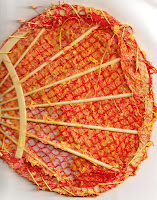
 On defrosting the paper pulp that was left from previous chapter I realised the pink and grey pulp would need to be coloured. While it defrosted I pulled the threads on a neutral a fabric. Realising that by using Brusho powder of blue and yellow for the pulp would also colour the fabric I set the fabric on cloth pads and then proceeded to make the paper.
On defrosting the paper pulp that was left from previous chapter I realised the pink and grey pulp would need to be coloured. While it defrosted I pulled the threads on a neutral a fabric. Realising that by using Brusho powder of blue and yellow for the pulp would also colour the fabric I set the fabric on cloth pads and then proceeded to make the paper.The effects presented were not too dramatic. The blue samples 4.7b 1 and 2 above show the colouring bleeding into the fabric but not obliterate the neutral colour completely. In sample 1 the threads had been pulled but left at top and botton to provide a curled textural effect. In sample 2 the pulled threads were laid loosely onto a cloth pad before being layered with a thin layer of pulp. Possibly the nicest effect was the build up of paper ridges in sample b1 where layers of pulp from various dippings began to form on the cloth sample. This textural effect - an accident - could play an important design feature in later chapters.
The yellow colouring, seen in sample 4.7b3 below, did not completly deaden the pink flecks in the pulp but produced a bright lemon yellow fabric to back the orange paper - the variegated perle thread used in the sample appeared to be uneffected. The grid was decorated with diagonal lines of perle thread to interpret lines of lettering which will be emphasied in later chapters.
With an attempt on apply pulp to the fan I did a 'belts and braces' job on the mesh used to cover the shape, see samples below 4.7b4a,b,and c. Two thicknesses of mesh were used and the fan was plunged into pulp bath and the result shows that I probably should have double dipped or used one mesh. Although I did not want complete coverage much of the paper stuck to the mesh when dried. The resulting paper was not a complete disaster - it had texture, but of the mesh rather than the ridges, and it also had a hint of a letter in the alphabet which looked promising!
On my next sample, below 4.7b.5 I decided to leave the wrappings of thread and ribbon, which had been dipped into paper pulp, on the frame. In order to use this as a sample for the next chapter Stitchery on Paper I felt the tension of the frame would help me in the stitching process.
At the end of this exercise I decided to muse further on the sample from my last chapter, shown below, it had been my idea to work on this as a grid on the fan shape and dip into paper. But having seen the ridges forming on paper pulp in 4.7b1 I was considering forming 'fabric' into the angle panel shapes of the fan with the paper ridges forming the structure. Sian had suggested that the fan shape could be made from gathering one edge of a rectangle. There was much to muse . So this fabric was to be saved for more experimentation when I had time to get my head around the structure that would be the outcome!
For now the task is to set off and consider backing fabrics for the samples in this chapter and start stitching.




















